20 Best Native Plants for Arkansas
BY KIMBERLY MAGERL | MAY 9TH, 2023 | ARKANSAS, LAWN CAREArkansas offers mountainous trails, serene lakes, running rivers, and fertile valleys. Located south of Missouri with the Mississippi River running the length of its western border, the Natural State is home to seven national parks. The diverse state has all the natural charm you could ever dream of. Invite some local nature into your landscape by filling your yard with some of the best native plants for Arkansas.
Native plants offer many landscaping benefits, including:
- Native plants support a diverse ecosystem, providing food and shelter for local wildlife, birds, and insects.
- They are acclimated to the subtropical climate and four distinct seasons.
- They are low-maintenance, surviving northern Arkansas frost, local insects, and disease.
Native plants help promote a healthier Arkansas ecosystem. Check out these 20 native plants to help you plan your natural landscape.
In this article, we’ll cover:
- 20 Native Plants for Your Arkansas Yard
- American Beautyberry
- Arkansas Beardtongue
- Azaleas
- Brown-eyed Susan
- Bluestar
- Butterfly Milkweed
- Early Buttercup
- Eastern Redbud
- False Solomon’s Seal
- Florida Anise Tree
- Lady Fern
- Net-leaf Leather-flower
- Purple Coneflower
- Red Buckeye
- Rose Vervain
- Roughleaf Dogwood
- Summersweet
- Sweetbay Magnolia
- Sweetshrub
- Tall Tickseed
- How to Choose Native Plants for Your Arkansas Landscape
- FAQ About Native Arkansas Plants
- Where to Find Native Plants in Arkansas
20 Native Plants for Your Arkansas Yard
1. American Beautyberry (Callicarpa americana)
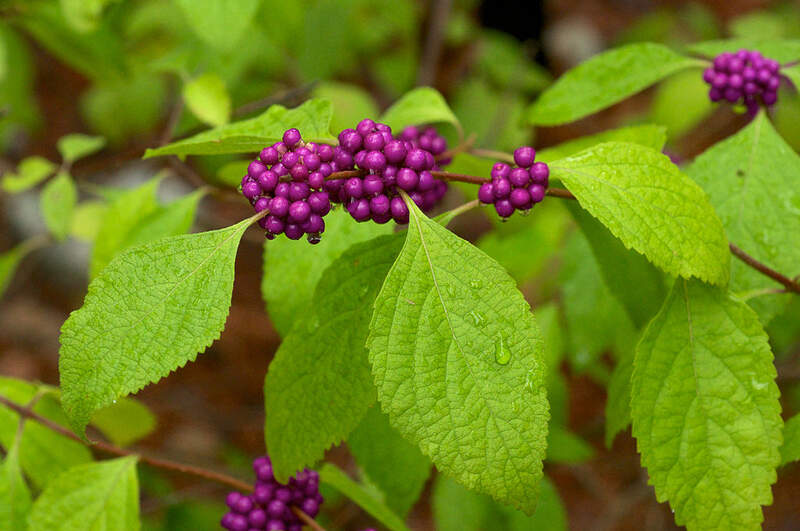
Photo Credit: Eric Hunt / Wikimedia Commons / CC BY-SA 3.0
American beautyberry is a large deciduous shrub that works well in woodland gardens, natural areas, and as an understory shrub in dappled shade. Mature branches arch toward the ground, growing denser with additional sunlight. A member of the mint family, this shrub produces bright purple fruits that attract birds and other wildlife.
Beautyberry has small lavender flowers and fuzzy, light green leaves. The shrub blooms from spring to summer before maturing to fruits in September. Beautyberry is drought tolerant and adapts well to most soils but prefers well-drained, rich, organic soil. It grows well throughout Arkansas but is found less frequently in the upper Ozark counties.
Growth habit: Shrub
USDA hardiness zone: 7-11
Mature size: 3-8 feet tall and 4-8 feet wide
Duration: Perennial
Foliage: Deciduous
Sunlight needs: Full sun to partial shade
Soil preferences: Adaptable; prefers well-drained, nutrient-rich soil but tolerates acidic, sandy soil
Water needs: Drought-tolerant; prefers a regular watering schedule and moist roots
Potential hazards: Non-toxic; cooked fruit can be made into jelly
2. Arkansas Beardtongue (Penstemon arkansanus)
Arkansas beardtongue is an herbaceous perennial with showy white or pink tubular flowers that bloom in the spring. Reaching heights up to 2 feet, slender stems ascend with paired dark green oblong leaves. The herbaceous flower grows well in the mountainous Interior Highland and Ozark regions encompassing northwest Arkansas and throughout most of Arkansas, except the Delta and coastal plains regions.
Like most beardtongues, Arkansas beardtongue grows best in full sun and prefers well-drained soils. Plant this attractive herb in garden beds to form flowering colonies. The Arkansas native is especially beneficial to local bees and pollinators.
Growth habit: Herb
USDA hardiness zone: 3-8
Mature size: Up to 2 feet tall
Duration: Perennial
Foliage: Deciduous
Sunlight needs: Full sun
Soil preferences: Adaptable; prefers well-drained, moist to dry loamy soils; tolerates well-drained clay soil
Water needs: Drought-tolerant; water 1 inch per week in the summer
Potential hazards: Low toxicity; poisonous to animals, including horses and poultry, in large quantities
3. Azaleas (Rhododendron)
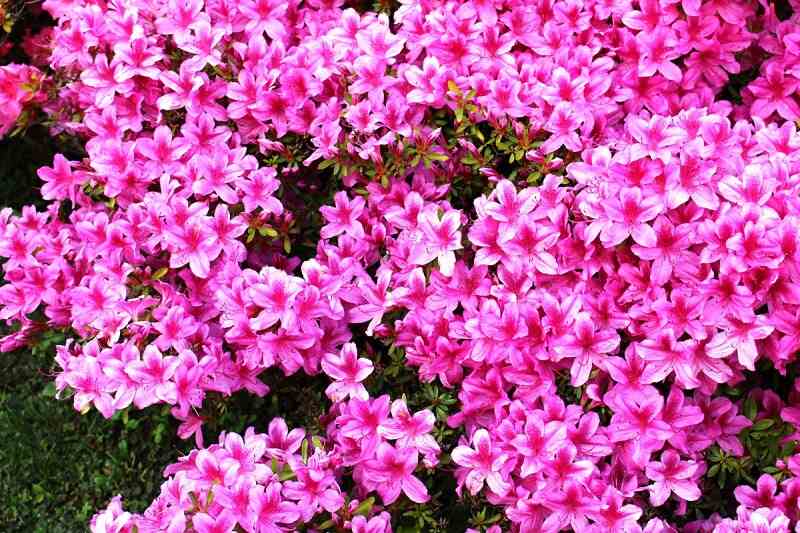
Photo Credit: Pxhere
Azaleas are the most common landscape shrub in Arkansas, leading some to consider it the state shrub. They are a family of flowering shrubs with several deciduous species native to Arkansas. Vibrant spring blooms attract pollinating insects, while the dried stalks provide shelter for songbirds in the winter.
Azaleas prefer dappled shade and thrive in the well-drained, rich, moisture-retaining soils found in the southern two-thirds of the state. Plant these beautiful blooms as part of mass plantings, woodland gardens, mixed borders, and pollinator gardens. The three most common azaleas native to Arkansas include:
- Mountain Azalea (Rhododendron canescens): This azalea is another spring-blooming showy flowering shrub with vibrant pink tubular blooms with long stamens.
- Roseshell Honeysuckle Azalea (Rhododendron prinophyllum): The most common native azalea, this showy shrub blooms pinkish-white, funnel-shaped flowers amongst attractive hairy leaves.
- Swamp Azalea (Rhododendron viscosum): Originating near wetlands, streams, rivers, and lakes throughout southern Arkansas, this loose-growing deciduous shrub blooms fragrant white to light pink flowers in the spring.
Growth habit: Shrub
USDA hardiness zone: 6-9
Mature size: 4-12 feet tall and wide
Duration: Perennial
Foliage: Deciduous
Sunlight needs: Partial shade
Soil preferences: Prefers well-drained, rich, humusy, acidic, moisture-retentive soils
Water needs: About 1 inch of water or rainfall per week
Potential hazards: Toxic; poisonous to humans and animals
4. Brown-eyed Susan (Rudbeckia triloba)
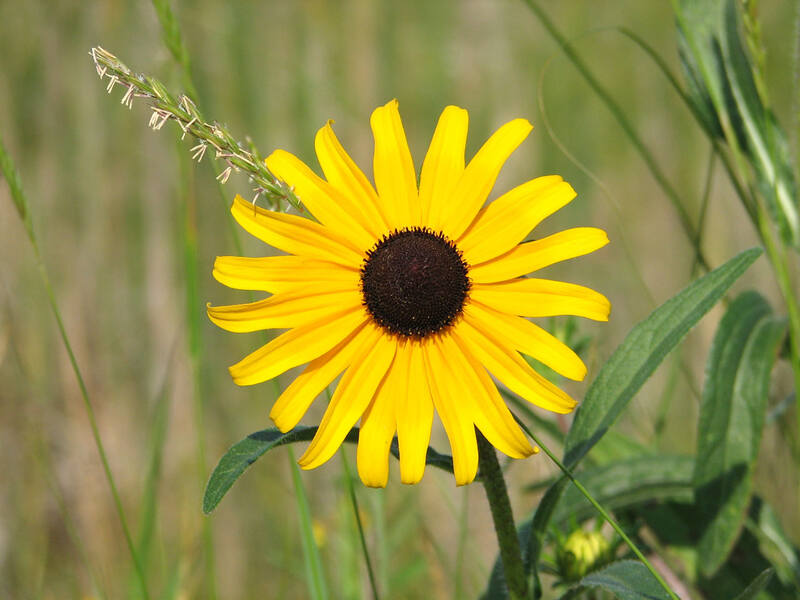
Photo Credit : PublicDomainPictures
Brown-eyed Susan is the only naturally occurring species of Rudbeckia in Arkansas, growing across the Ozark, Valley, and Ouachita Mountain regions. Like its cousin, black-eyed Susan, it is recognizable for its bright gold petals and dark brown centers. The herbaceous wildflower is deer-resistant and taller, with a more sparse growth habit than its cousin. It makes a great addition to naturalized home landscapes and rain gardens.
Transplanted flowers or sewn seeds grow well in garden beds and containers. Brown-eyed Susan flowers grow atop clumping, three-lobed leaves. They love full sun and well-drained, moist soil. The sunny blooms are important to Arkansas butterfly conservation efforts, attracting birds and local pollinators.
Growth habit: Herb
USDA hardiness zone: 4-8
Mature size: 3-5 feet tall and 1.5-2.5 feet wide
Duration: Biennial or short-lived perennial
Foliage: Deciduous
Sunlight needs: Full sun to partial shade
Soil preferences: Adaptable; prefers well-drained, moist to wet, rich soil
Water needs: Drought-tolerant; 1 inch of water or rainfall per week
Potential hazards: Low toxicity; some humans have an allergy to daisies
5. Bluestar (Amsonia hubrichtii)
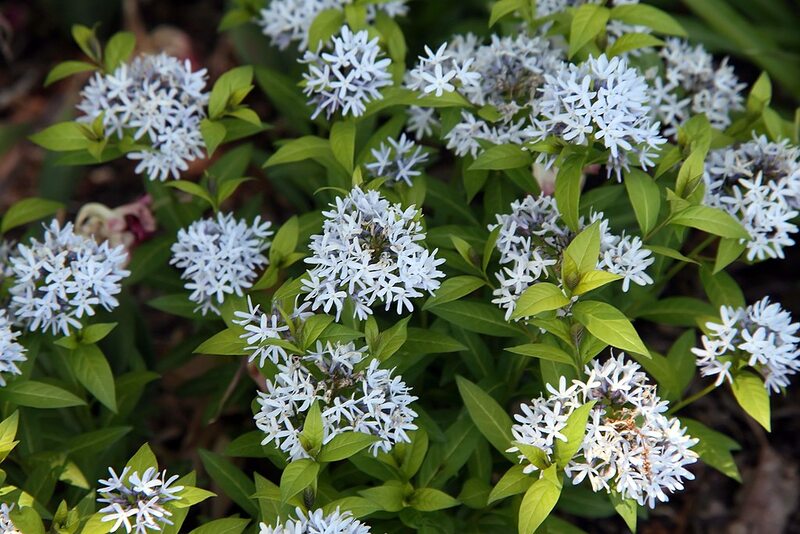
Photo Credit: David J. Stang / Wikimedia Commons / CC BY-SA 4.0
Bluestar, also known as Hubricht’s bluestar and threadleaf bluestar, is native to central Arkansas and grows naturally in the Ouachita Mountain range. It is a clumping, herbaceous perennial with small lavender, star-shaped flowers that bloom in spring amongst grass-like leaves.
The low-maintenance ornamental plant is popular in home landscapes thanks to its narrow, bright green foliage that lasts through summer and turns golden yellow in the fall. Bluestar makes a great addition to rock gardens, woodland areas, and mass flower bed plantings. It is an attractive pollinator plant and deer-resistant.
Growth habit: Herb
USDA hardiness zone: 5-8
Mature size: 2-3 feet tall and up to 4 feet wide
Duration: Perennial
Foliage: Deciduous
Sunlight needs: Full sun to partial shade
Soil preferences: Adaptable; prefers well-drained average to medium-weight soil
Water needs: About 1 inch of water or rainfall per week
Potential hazards: Low toxicity; milky sap irritates humans and animals
6. Butterfly Milkweed (Asclepias tuberosa)
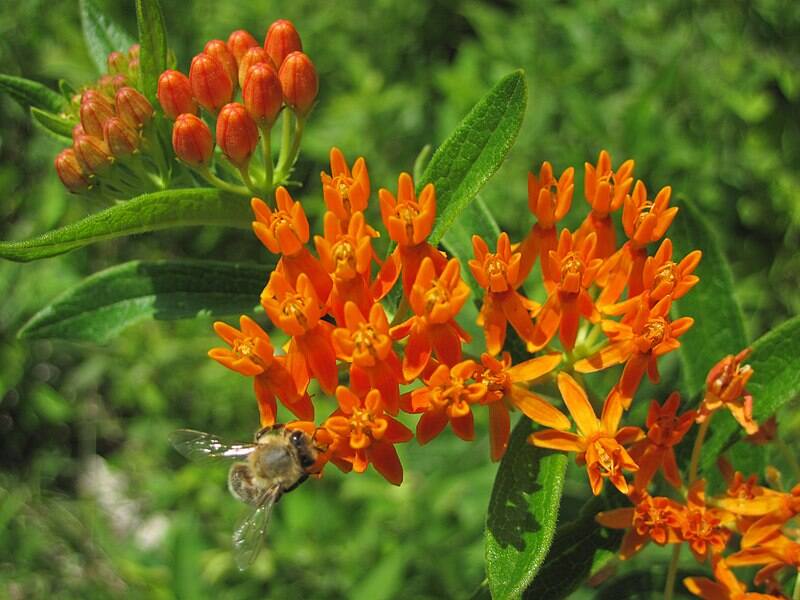
Photo Credit: James St. John / Wikimedia Commons / CC BY 2.0
Butterfly weed is a native species of milkweed and is extremely important to healthy Arkansas landscapes. It is an attractive flowering plant and a nectar source for bees and pollinators and a host plant for caterpillars, including the Monarch butterfly and Unexpected Tiger moth. There are around 14 native species of milkweed that grow throughout Arkansas and all are part of the Arkansas Monarch Conservation Partnership.
Butterfly weed produces bright orange or yellow flowers from summer to fall. The attractive plant is hardy and loves full sun. It tolerates most soils but prefers sandy well-draining soil and is moderately drought-tolerant.
Growth habit: Herb
USDA hardiness zone: 3-10
Mature size: 1-4 feet tall and less than 1 foot wide
Duration: Perennial though some species are annuals
Foliage: N/A
Sunlight needs: Full sun
Soil preferences: Prefers dry, sandy soil or gravel
Water needs: Semi drought-tolerant; prefers to dry out between waterings
Potential hazards: Low toxicity; milky sap irritates humans and animals
7. Early Buttercup (Ranunculus fascicularis)
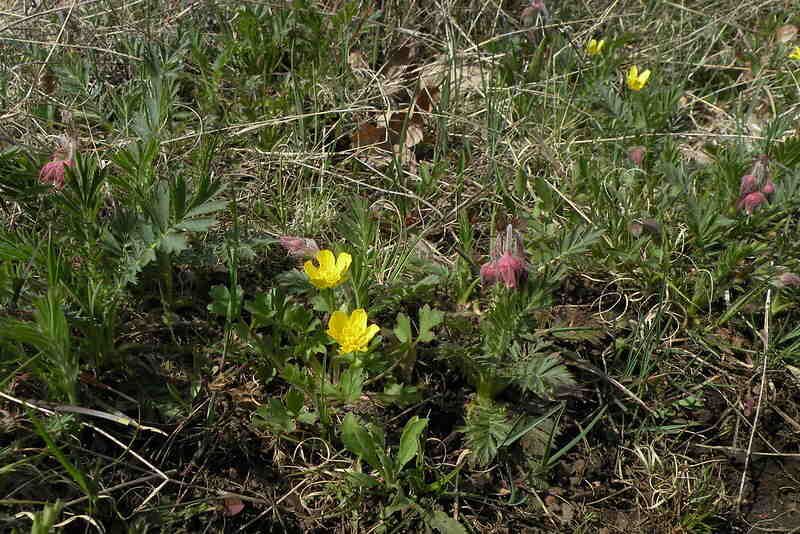
Photo Credit: DougMcGrady / Flickr / CC BY 2.0
Early buttercup is an herbaceous winter perennial growing statewide throughout Arkansas. Glossy yellow flowers bloom in early March among three-lobed leaves. It is one of 17 species of buttercup growing throughout the Natural State. The flowering herb adapts to a range of soils and habitats, including shady woods, sunny grasslands, and home lawns.
Early buttercup makes a great green addition to your winter landscape. It grows well in garden beds and pollinator gardens. However, be mindful of planting in shaded areas where rapid self-seeding and colonization occur. The glossy blooms attract numerous pollinators, game birds, and small mammals.
Growth habit: Herb
USDA hardiness zone: 5-9
Mature size: 6-12 inches tall
Duration: Perennial
Foliage: N/A
Sunlight needs: Full sun, partial shade, shade
Soil preferences: Prefers rich, well-drained soil
Water needs: Drought-tolerant; one inch of water or rainfall per week
Potential hazards: Low toxicity; minor skin irritation lasting minutes if touched; low toxicity if ingested
8. Eastern Redbud (Cercis canadensis)
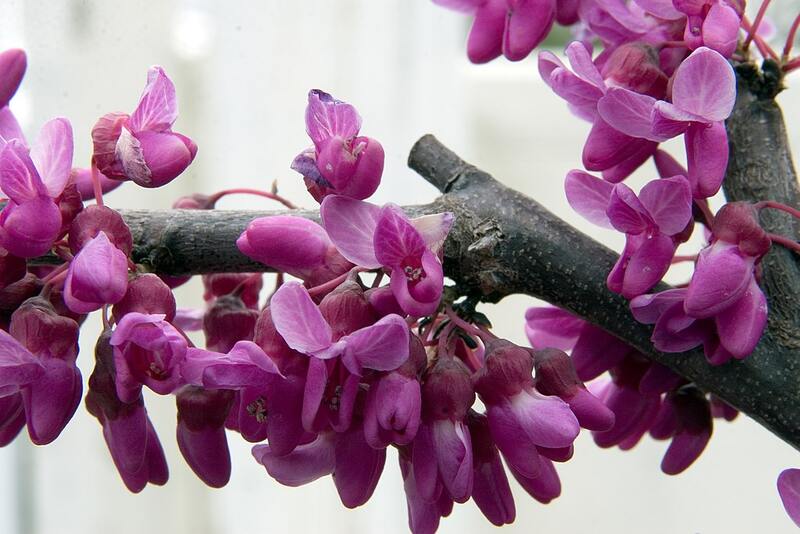
Photo Credit: David J. Stang / Wikimedia Commons / CC BY-SA 4.0
Eastern redbud is a small deciduous tree with a dense canopy growing statewide. It produces small clusters of showy pink flowers over its bare branches in spring. Blooms last for two to three weeks before giving way to heart-shaped dark green leaves that turn golden in the fall.
Eastern redbud works well as shrub borders and fringe trees. Those low-maintenance cultivars require little pruning and attract many birds and pollinators. They have a short trunk and rounded crown of spreading branches. Unfortunately, these beautiful trees have a short lifespan of around 35-40 years.
Growth habit: Tree
USDA hardiness zone: 3-8
Mature size: Up to 30 feet tall
Duration: Perennial
Foliage: Deciduous
Sunlight needs: Partial shade to full shade
Soil preferences: Prefers moist, fertile, well-drained soil
Water needs: About 1 inch of water or rainfall per week
Potential hazards: Toxic; poisonous to dogs and cats
9. False Solomon’s Seal (Maianthemum racemosum)
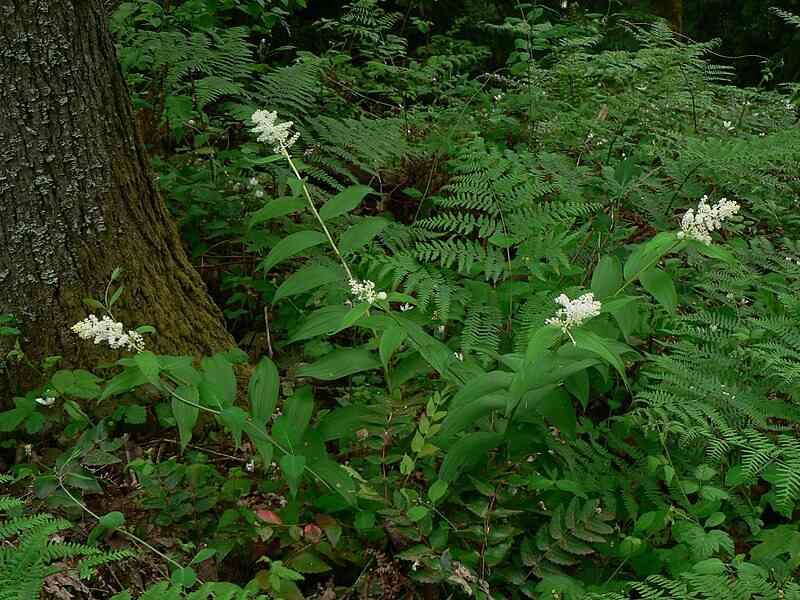
Photo Credit: Walter Seigmund / Wikimedia Commons / CC BY-SA 3.0
Like traditional Solomon’s Seal, false Solomon’s seal is a member of the lily family. It occurs naturally in northwestern Arkansas and Crowley’s Ridge. It is an excellent shade plant with arching stems that produces large leaves and clusters of tiny white flowers in late spring followed by vibrant red berries in June.
False Solomon’s seal attracts birds and small mammals. Unlike its cousin variegated Solomon’s seal, this variety is not deer-resistant. Plant the herbaceous perennial alone, away from competition in a shaded garden area or on the north side of your Arkansas landscape. It spreads quickly, leading some gardeners to consider it an aggressive species.
Growth habit: Herb
USDA hardiness zone: 3-8
Mature size: Arching stems reach up to 4 feet long
Duration: Perennial
Foliage: Deciduous
Sunlight needs: Partial shade to full shade
Soil preferences: Prefers deep, moist, rich, acidic soils
Water needs: Drought-tolerant; 1 inch of water or rainfall per week
Potential hazards: Non-toxic; edible
10. Florida Anise Tree (Illicium floridanum)
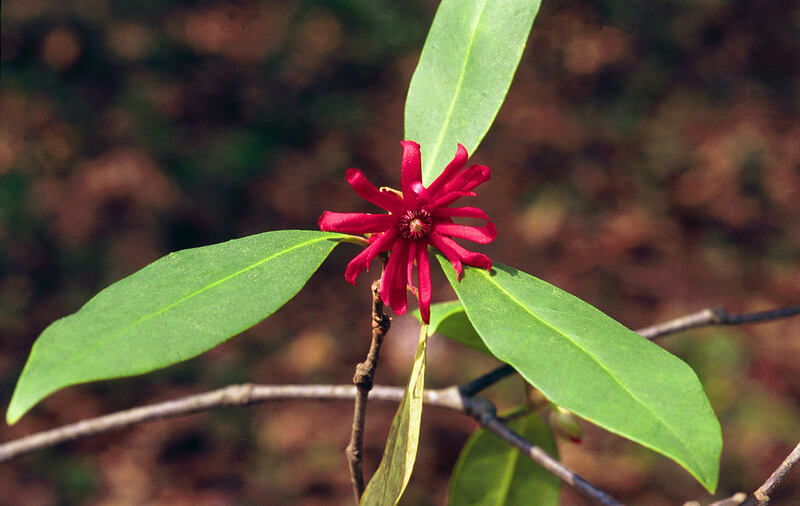
Photo Credit: Ted Bodner / Wikimedia Commons / CC BY 3.0 US
Purple anise, or the Florida anise tree, is actually an evergreen shrub with small star-shaped purple to red flowers. Its skinny branches droop to the ground, giving the shrub a rounded shape while its flowers bloom in spring with fruits following from late summer to fall. The fruits of the Florida anise tree give off a distinct licorice odor when crushed like its cousin star anise. The evergreen shrub grows throughout Arkansas and is most commonly found near streams, lakes, and ravines.
Florida anise has a dense growth pattern, making it ideal for windbreaks and hedgerows. They grow well in partial shade but prefer full sun and respond well to pruning. They love rich soil and moisture but adapt to most conditions. The purple anise is winter hardy to minus 10 degrees Fahrenheit and its foliage is poisonous, making it resistant to insects and deer.
Growth habit: Shrub
USDA hardiness zone: 8-10
Mature size: 10-15 feet tall and 6-10 feet wide
Duration: Perennial
Foliage: Evergreen
Sunlight needs: Full sun to partial shade
Soil preferences: Prefers rich, moist soil, clay, sand, or loam
Water needs: Drought-tolerant; 1 inch of rainfall or water per week
Potential hazards: Toxic; foliage is poisonous to humans and animals
11. Lady Fern (Athyrium filix-femina)
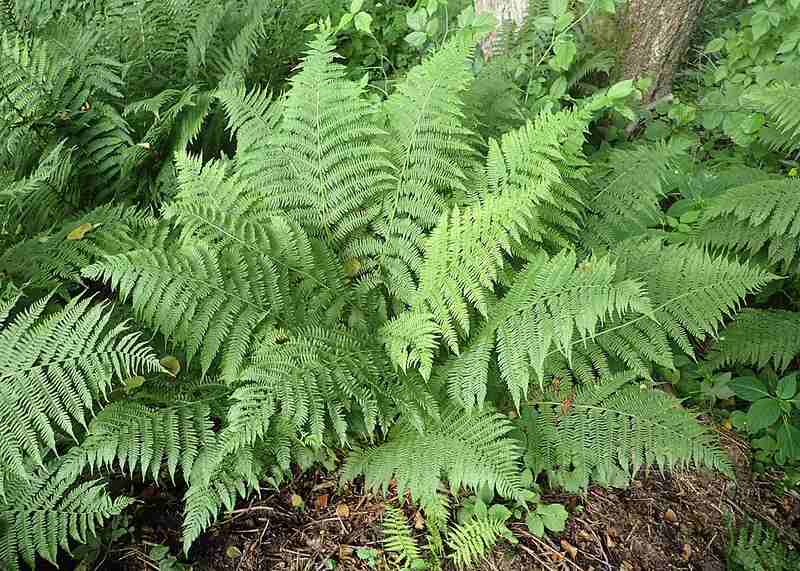
Photo Credit: Krzysztof Ziarnek / Wikimedia Commons / CC BY-SA 4.0
Lady fern is a medium-sized fern growing throughout Arkansas, North America, and even Alaska and Canada. It loves shaded woods and swampy regions but adapts to most soils and climates. Lady fern has an attractive and delicate appearance, with short leaflets running the lengths of divided, wispy fronds.
Lady fern is low-maintenance and extremely cold hardy, making it a great choice for northern Arkansas landscapes. It makes a great addition to shade gardens and natural landscapes with moist soil. The slow-growing perennial will go dormant during times of drought and is easily damaged by wind or animals.
Growth habit: Herb, fern
USDA hardiness zone: 3-8
Mature size: Up to 3 feet tall
Duration: Perennial
Foliage: Deciduous
Sunlight needs: Partial shade to full shade
Soil preferences: Prefers moist, humus-rich soil
Water needs: Semi drought-tolerant once established; prefers regular watering and evenly moist soil, never soggy
Potential hazards: Low toxicity; raw plant is poisonous to humans and animals in large quantities; cooked plant is used as a food source in some cultures
12. Net-Leaf Leather-Flower
Net-leaf leather-flower is another member of the native Arkansas buttercup family. This herbaceous vine grows in north-central and southwestern Arkansas, preferring dry, sandy, or rocky soils. Mature specimens can produce multiple vines with bright green leaf pairs. Vines grow upright with supports like trellises or trees but will crawl across and over other plants, anchoring themselves to grow upright.
Net-leaf leather-flower produces unique, lavender, bell-shaped blooms in the spring that resemble upside-down cups. The attractive vine grows to 12 feet tall and makes a great addition to any Arkansas garden with partial shade and moist soil. Avoid tying the delicate branches. Instead, plant specimens near trellises, fences, arbors, large shrubs, or small trees.
Growth habit: Vine
USDA hardiness zone: 6-9
Mature size: Up to 12 feet tall
Duration: Perennial
Foliage: Deciduous
Sunlight needs: Partial shade
Soil preferences: Adaptable; grows well in any soil with average moisture and partial shade
Water needs: Drought-tolerant; water 1 inch per week
Potential hazards: Low toxicity; poisonous to humans and animals but rarely consumed
13. Purple Coneflower (Echinacea purpurea)
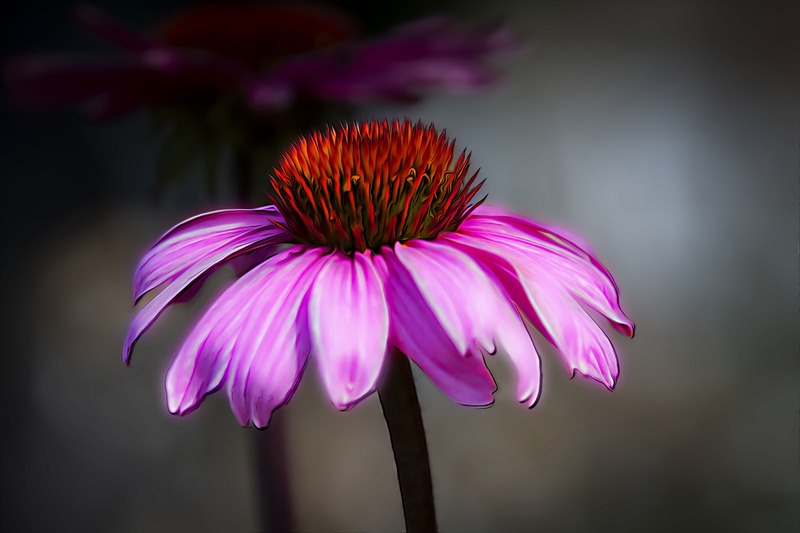
Photo Credit: PublicDomainPictures
Purple coneflower is a member of the Arkansas Monarch’s conservation efforts and is important to Arkansas’ healthy ecosystem. The attractive flowering herb grows throughout the state except for the West Gulf Coastal and Mississippi Plains. Purple coneflower makes a great addition to rock gardens, flower beds, containers, and pollinator gardens.
The wild herb produces showy blooms with slender, pinkish-purple petals around large, round orange-brown centers. Erect stems grow to heights of three feet among large, serrated bright green leaves. Purple coneflower tolerates mild drought conditions, heat, and a variety of soil conditions. It attracts butterflies, hummingbirds, and other pollinators, and like bluestar and brown-eyed Susan, is deer-resistant.
Growth habit: Herb
USDA hardiness zone: 3-9
Mature size: Up to 4 feet tall
Duration: Perennial
Foliage: Deciduous
Sunlight needs: Full sun to partial shade
Soil preferences: Well-drained, rich soil or sand
Water needs: 1 inch of water or rainfall per week
Potential hazards: Non-toxic; no safety hazards
14. Red Buckeye (Aesculus pavia)
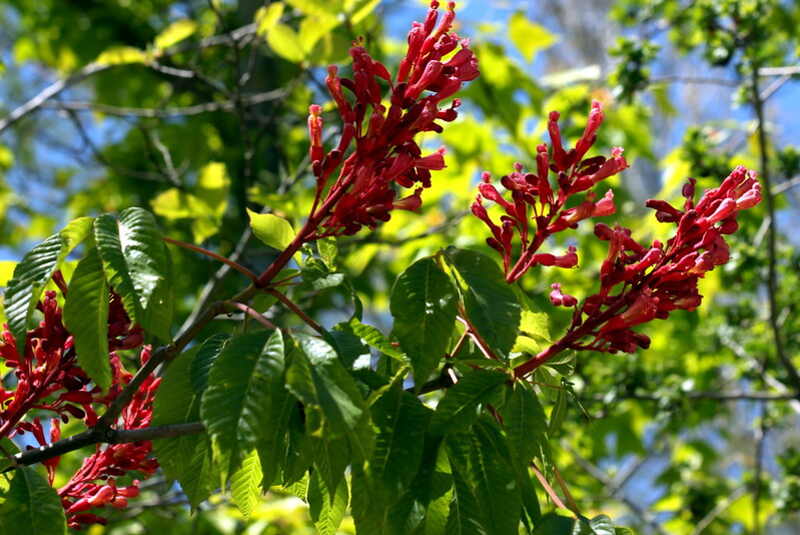
Photo Credit: manuel m. v. / Flickr / CC BY 2.0
Red buckeye, or scarlet buckeye, is a large shrub or small tree growing throughout Arkansas except for the Western Ozarks and the banks of the Mississippi River. In nature, it is an understory or mixed woodland tree that loves deep, well-drained soils and full sun.
Tubular red flowers attract hummingbirds and pollinators in the spring, while attractive flaky bark adds visual interest. It has a rounded top and a broad growth pattern. The small tree is part of the Arkansas Monarch’s conservation efforts. Plant red buckeyes anywhere that is too small for a larger tree. When choosing an area for planting, keep in mind that these specimens produce poisonous seeds resembling reddish-brown acorns that drop to the ground in the fall.
Growth habit: Shrub, tree
USDA hardiness zone: 4-8
Mature size: 10-40 feet tall; usually 20 feet tall in Arkansas
Duration: Perennial
Foliage: Deciduous
Sunlight needs: Partial shade
Soil preferences: Prefers deep, acidic, well-drained sand, clay, loam, or limestone
Water needs: 1 inch of water or rainfall per week
Potential hazards: Moderate toxicity; seeds are poisonous to humans and animals, including horses and livestock; often used to make soap
15. Rose Vervain (Glandularia canadensis)
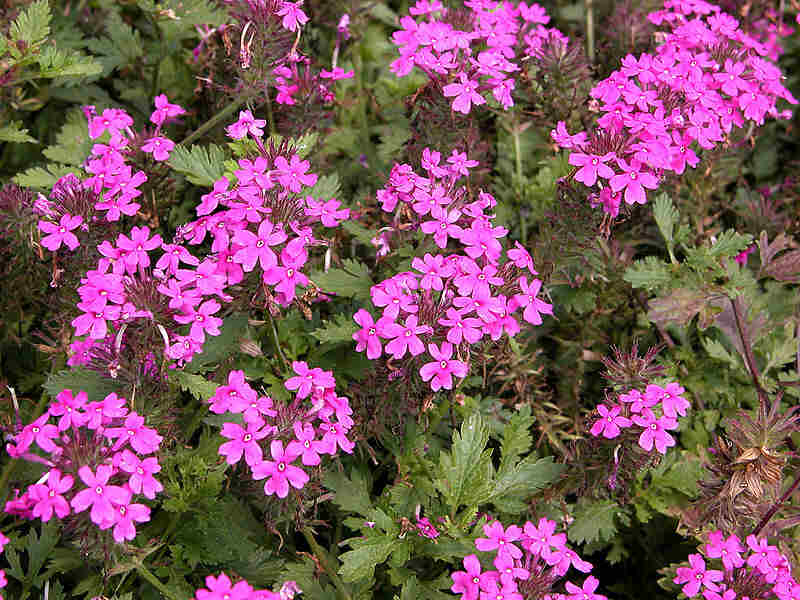
Photo Credit: Carl Lewis / Wikimedia Commons / CC BY 2.0
Rose vervain is another important pollinator for Arkansas, attracting local bees and butterflies. It is a creeping, low-growing herb that produces clusters of fragrant pink, five-petaled flowers. Rose vervain grows naturally throughout Arkansas except for the areas encompassing the Mississippi Plain.
The perennial grows best in partial shade. It requires weekly watering during the dry summer months or it will lose its leaves. Plant rose vervain in borders, rock gardens, and containers. The showy herb also makes an attractive groundcover.
Growth habit: Herb
USDA hardiness zone: 5-9
Mature size: Up to 10 inches tall
Duration: Perennial; sometimes annual during harsh winters in northern Arkansas
Foliage: Evergreen
Sunlight needs: Partial shade
Soil preferences: Adaptable; prefers poor, acidic, sandy, rocky, moist, well-drained soils
Water needs: 1 inch of water or rainfall per week
Potential hazards: Non-toxic; no safety hazards
16. Roughleaf Dogwood (Cornus drummondii)
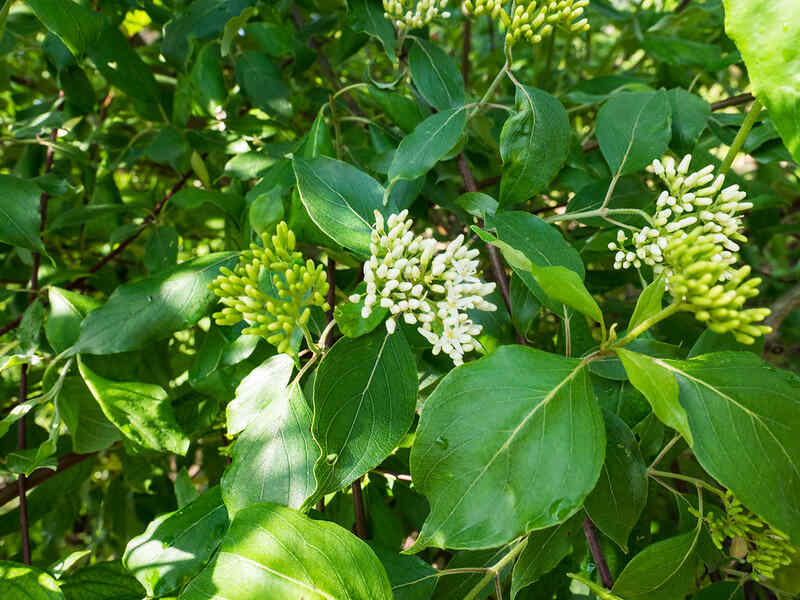
Photo Credit: F. D. Richards / Flickr / CC BY-SA 2.0
Roughleaf dogwood is a small tree or large shrub with a clumping growth habit. Growing statewide except for the Coastal Plain, this fragrant tree blooms creamy yellow flowers in clusters alongside hard, white fruit.
Roughleaf dogwood gets its name from its rough leaf surfaces. The tree adapts to most light conditions and soils but grows more densely in full sunlight. It makes a great addition to property barriers, natural areas, stream banks for erosion control, and sunny patio areas. It is one of five Arkansas dogwoods.
Growth habit: Tree
USDA hardiness zone: 4-9
Mature size: Up to 20 feet tall
Duration: Perennial
Foliage: Deciduous
Sunlight needs: Full sun to partial shade
Soil preferences: Adaptable; calcareous, acidic, alkaline, limestone, sand, sand-loam, medium loam, clay loam, or clay
Water needs: Drought-tolerant; 1 inch of water or rainfall per week
Potential hazards: Non-toxic; no safety hazards
17. Summersweet (Clethra alnifolia)
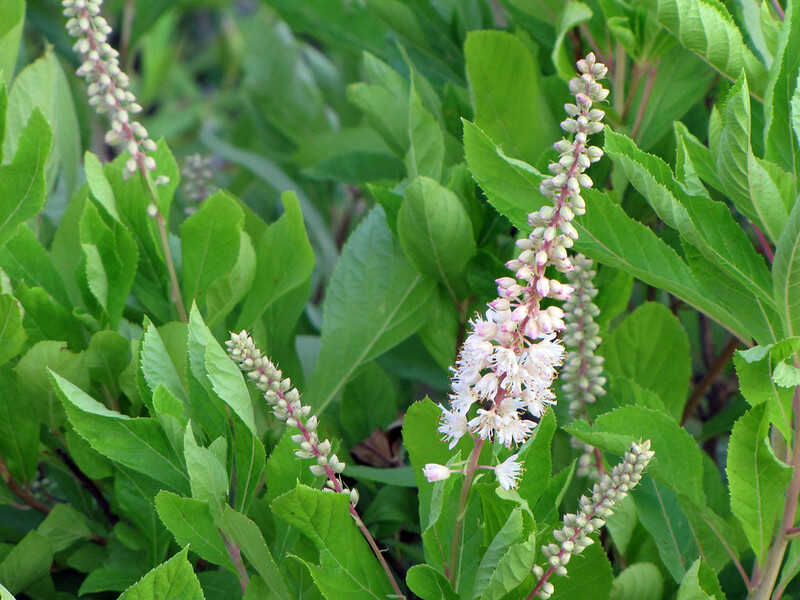
Photo Credit: Katja Schluz / Flickr / CC BY 2.0
Summersweet is an attractive landscape shrub producing visual interest no matter the season. The deciduous perennial produces shiny green leaves in the spring, spiky pink or white flowers in the summer, yellow leaves in the fall, and delicate seed capsules that attract birds and small mammals in the winter.
Summersweet grows statewide. It has an open growth pattern and soft texture. The fragrant shrub prefers partial shade and makes a great addition to pollinator gardens, natural landscapes, and mixed borders.
Growth habit: Shrub
USDA hardiness zone: 4-9
Mature size: 3-8 feet tall
Duration: Perennial
Foliage: Deciduous
Sunlight needs: Partial shade
Soil preferences: Adaptable; prefers acidic, moist, well-drained soil
Water needs: 1 inch of water or rainfall per week; do not let the soil dry out completely
Potential hazards: Non-toxic; no safety hazards
18. Sweetbay Magnolia (Magnolia virginiana)
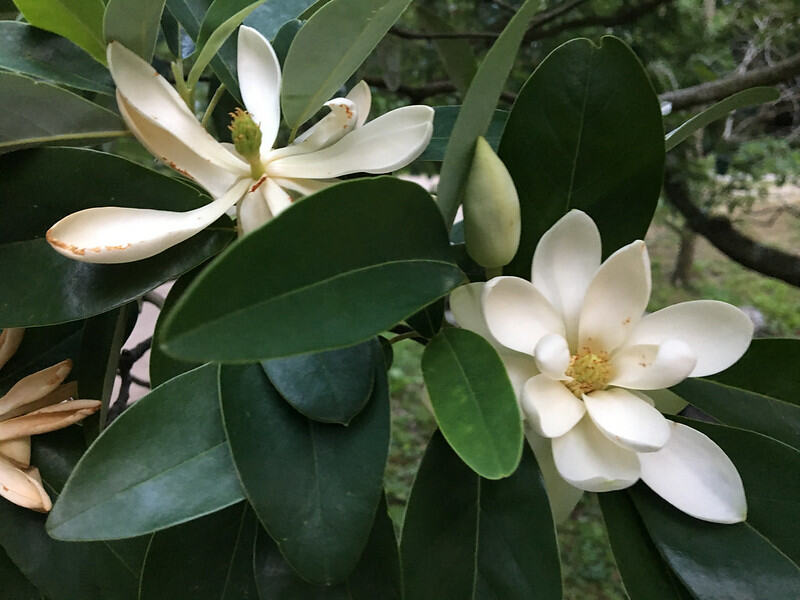
Photo Credit: Plant Image Library / Flickr / CC BY-SA 2.0
Sweetbay magnolia is a wide-growing semi-evergreen tree that reaches heights of 60 feet in Arkansas. The slow-growing tree has no natural pest or disease enemies and responds well to pruning after its active growing season before winter dormancy. It makes a great patio or specimen tree.
Sweetbay magnolia produces white, lemon-scented flowers from summer through fall, and its vibrant red seeds attract songbirds and small mammals. The medium-sized tree has medium green, glossy leaves. In the southern half of Arkansas, sweetbay magnolia retains its leaves. However, in the colder cities of northern Arkansas, it will lose its leaves in the winter.
Growth habit: Tree
USDA hardiness zone: 5-10
Mature size: 40-50 feet tall and 15-25 feet wide; trunk up to 3 feet in diameter
Duration: Perennial
Foliage: Semi-evergreen
Sunlight needs: Full sun to partial shade
Soil preferences: Adaptable; rich, moist, acidic, sand, sand-loam, medium loam, clay loam, or clay
Water needs: 1 inch of water or rainfall per week
Potential hazards: Non-toxic; no safety hazards
19. Sweetshrub (Calycanthus floridus)
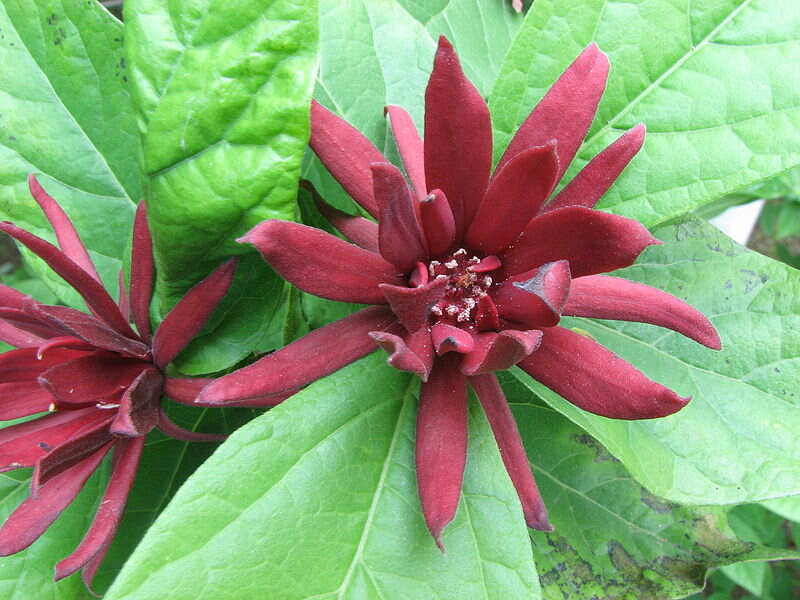
Photo Credit: GFDL&CC / Wikimedia Commons / CC BY-SA 3.0
Sweetshrub, also known as Carolina allspice, is a large deciduous shrub. It has a rounded growth pattern with glossy, leathery, dark green leaves. Like sweetbay magnolia, specimens are very pest and disease-resistant.
The fragrant shrub is tall with an open and upright growth habit. It produces fragrant maroon flowers in the spring, followed by dry fruit. Because of its pleasant strawberry-like fragrance, most homeowners plant sweetshrub near patios or entryways.
Growth habit: Shrub
USDA hardiness zone: 4-9
Mature size: 6-9 feet tall
Duration: Perennial
Foliage: Deciduous
Sunlight needs: Full sun to partial shade
Soil preferences: Rich, semi-moist, well-drained soil
Water needs: 1 inch of rainfall or water per week
Potential hazards: Low toxicity; seed pods are poisonous if consumed in large quantities
20. Tall Tickseed (Coreopsis tripteris)
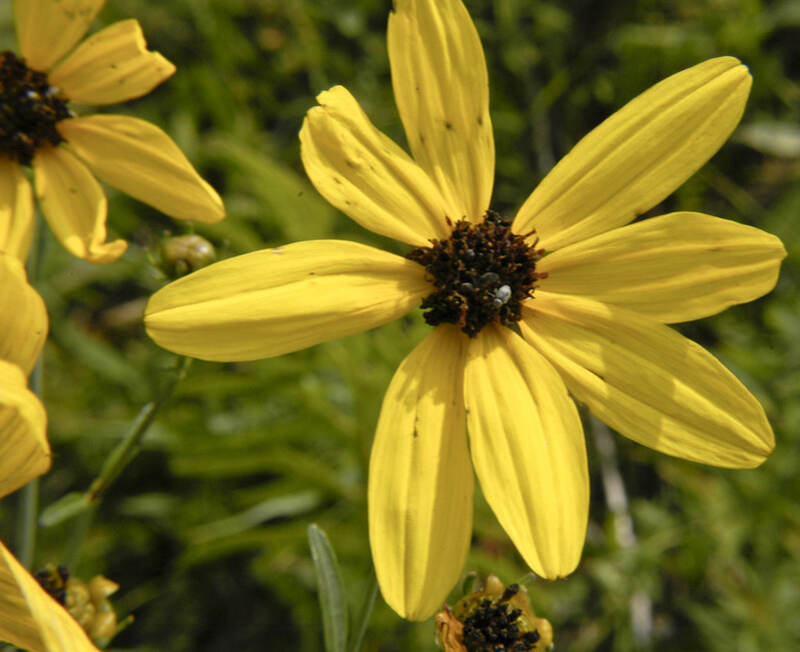
Photo Credit: Frank Mayfield / Flickr / CC BY-SA 2.0
Tall tickseed is a member of the aster or sunflower family and an important member of Arkansas’ butterfly conservation efforts. It grows naturally throughout most of Arkansas, with the exception of the Mississippi and West Gulf Coastal Plains. The herbaceous perennial blooms daisy-shaped, yellow flowers with brown-orange centers from spring to summer.
Tickseed is drought tolerant and reseeds itself. Its bright blooms attract butterflies and native pollinators. Tall tickseed makes a great addition to flower beds, butterfly gardens, and naturalized areas as it is deer-resistant.
Growth habit: Herb
USDA hardiness zone: 4-11
Mature size: 1-4 feet tall and 1-2 feet wide
Duration: Perennial
Foliage: N/A
Sunlight needs: Partial shade
Soil preferences: Adaptable; prefers moist, well-drained chalk, soil, sand, loam, or clay
Water needs: Drought-tolerant; 1 inch of rainfall or water per week
Potential hazards: Non-toxic, no safety hazards
How to Choose Native Plants for Your Arkansas Yard
Your yard has its own unique microclimate, and all native plants have specific needs. Not all native plants will grow well in your yard. Be sure to select plants suitable for the soil, sun exposure, and watering capabilities of your landscape.
Arkansas sits in USDA Hardiness Zones 6a to 8a, indicating the coldest annual temperature is -10 to -5 degrees Fahrenheit in the northernmost portion of the state. The majority of the Natural State falls within zones 7a and 7b. Arkansas native plants are cold-hardy to the minimum temperature in the hardiness zones. Keep your zone in mind when selecting non-native plants for your landscape.
FAQ About Native Arkansas Plants
Fall is the best time to plant trees and shrubs. Aim to plant native shrubs and trees in November. Wait until the last chance of frost in spring to plant native flowers and herbs. Plant your new spring landscape after April 15 in most of the state.
Arkansas’ diverse landscape is home to four dominant soil regions:
1. Regolith, sedimentary rock, gravel, and hard, stiff soils make up the Ozark Plateau region in northern Arkansas.
2. Well-drained, loose, rich, fertile clay soils make up the Mississippi River Alluvial Plain on the western one-third of the state.
3. Hard rock and impenetrable soils make up the Arkansas River Valley and Ouachita Mountain regions of central Arkansas.
4. Sand, silt, stiff clay, loess, and gravel make up the West Gulf Coastal Plain in the southern one-third of the Natural State.
The best way to identify your landscape’s soil type is to send a soil sample in for testing to your local University of Arkansas extension office.
Early morning or evening are the best times to water your native plants. Winds are calmer and temperatures are lower, so there is less risk of water loss from evaporation or scorching from the sun. Additionally, foliage needs time to dry before nightfall. Wet foliage can lead to disease and rot.
Where to Find Native Plants in Arkansas
Chances are good you already have native plants in your yard or around your neighborhood. If you want to introduce more plants into your Arkansas landscape, be sure to source your plants ethically and never transplant them from the wild.
Check out these resources to connect with local nurseries in your area:
- Arkansas Monarch Conservation Partnership
- Arkansas Native Plant Society
- University of Arkansas’ Division of Agriculture
Filling your yard with native plants is only one step in your landscaping design project. Be sure to maintain your new landscape by understanding your yard’s grass type and consider reducing your workload by introducing some low-maintenance landscaping ideas.
From the birthplace of Walmart to Little Rock and River Mountain, no matter where you live, you can turn over the hard work and lawn upkeep to a professional. Let WikiLawn connect you with a local landscaping pro in your area so you can spend more time exploring the great Natural State.
Main Image Credit: Redbud Tree / PublicDomainPictures